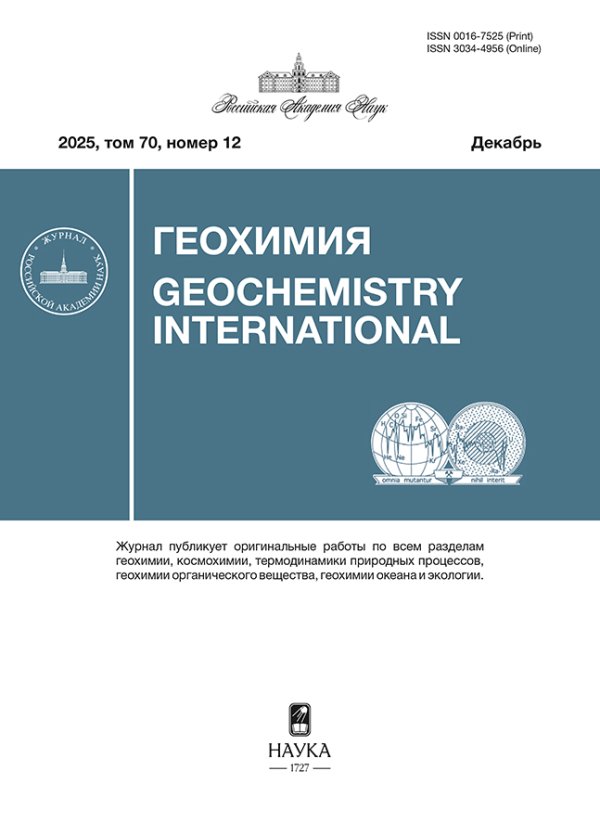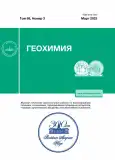Crystallogenetic Causes of the Unique Shape of the Matryoshka Diamond: The Effect of Capturing a Diamond Inclusion of Twin Diamond Crystals
- Authors: Pavlushin A.D.1, Konogorova D.V.2
-
Affiliations:
- Diamond and Precious Metal Geology Institute, Siberian Branch, Russian Academy of Sciences
- Faculty of Geology, Lomonosov Moscow State University
- Issue: Vol 68, No 3 (2023)
- Pages: 271-284
- Section: Articles
- URL: https://journals.rcsi.science/0016-7525/article/view/134794
- DOI: https://doi.org/10.31857/S001675252303010X
- EDN: https://elibrary.ru/METAAK
- ID: 134794
Cite item
Full Text
Abstract
The unusual shape of the Matryoshka diamond, which is a diamond crystal with a cavity containing a diamond crystal freely moving in it, continues to attract keen interest of many researchers in the context of its seemingly paradoxical origin for a mantle mineral. The discovery sparked lively discussions and multiple attempts to explain the nature of the unique shape of this crystal. A comprehensive mineralogical and crystallographic analysis of the unusual specimen, as well as other analogous diamond crystals, suggests that it was formed as a consequence of the mutual disorientation of the crystals during their growth and the presence of a twin of diamond subindividuals that formed both the core (inclusion) and the sheath (host) diamonds. The twinning planes (111) in the contacting crystals of the inclusion and the host were in a sub-perpendicular position to each other during their simultaneous growth. The captured diamond of the inclusion prevented the normal development of the diamond that became the host. The diamond host rapidly grew along the direction of its own twin boundary and constantly generated new growth layers, which eventually converged around the small captured twin crystal cluster during metric selection. Analysis of diamond crystals of similar shape from the Nyurbinskaya pipe and from elsewhere worldwide confirms the ontogenic model of their origin as a consequence of the capture of diamond inclusions that hampered the rapid growth of the twin crystal (spinel-law twins) in the direction of the twin boundary.
About the authors
A. D. Pavlushin
Diamond and Precious Metal Geology Institute, Siberian Branch, Russian Academy of Sciences
Email: pavlushin@diamond.ysn.ru
677000, Yakutsk, Russia
D. V. Konogorova
Faculty of Geology, Lomonosov Moscow State University
Author for correspondence.
Email: diana-96perm@mail.ru
119991, Moscow, Russia
References
- Бартошинский З.В., Квасница В.Н. (1991) Кристалломорфология алмаза из кимберлитов. Киев: Наукова думка, 172 с.
- Бескованов В.В. (2022) О возможном механизме образования алмаза-матрешки. Геология и минерально-сырьевые ресурсы северо-востока России, Материалы XII Всероссийской научно-практической конференции, посвященной 65-летию Института геологии алмаза и благородных металлов СО РАН. Изд.: СВФУ, Якутск, 283-286.
- Воробьев Ю.К. (1990) Закономерности роста и эволюции кристаллов минералов. М.: Наука, 184 с.
- Дементьева Г.И. (1963) Об индукционных поверхностях на кристаллах. Записки Всесоюзного минералогического общества. 92(4), 420-433.
- Жимулев Е.И., Чепуров А.И., Синякова Е.Ф., Сонин В.М., Чепуров А.А., Похиленко Н.П. (2012) Кристаллизация алмаза в системах Fe–Co–S–C и Fe–Ni–S–C и роль металл-сульфидных расплавов в генезисе алмазов. Геохимия. (3), 227-239.
- Zhimulev E.I., Chepurov A.I., Sinyakova E.F., Sonin V.M., Chepurov A.A., Pokhilenko N.P. (2012) Diamond crystallization in the Fe–Co–S–C and Fe–Ni–S–C systems and the role of sulfide-metal melts in the genesis of diamond. Geochem. Int. 50(3), 205-216.
- Зайцев A.M., Гиппиус А.А., Вавилов B.C. (1982) Люминесценция азотсодержащих примесно-дефектных комплексов в ионно-имплантированных слоях природного алмаза. Физика и техника полупроводников. 16(3), 397-403.
- Зинчук Н.Н., Коптиль В.И. (2003) Типоморфизм алмазов Сибирской платформы. М.: Недра, 603 с.
- Кедрова Т.В., Богуш И.Н., Зинчук Н.Н., Бардухинов Л.Д., Липашова А.Н., Афанасьев В.П. (2022) Россыпи алмазов Накынского кимберлитового поля. Геология и геофизика. 63(3), 291-302.
- Коногорова Д.В., Ковальчук О.Е., Бардухинов Л.Д. (2020) Уникальный алмаз из трубки Нюрбинская (Ныкынское кимберлитовое поле, Западная Якутия, Россия). Природные ресурсы Арктики и Субарктики. 25(2), 45-55.
- Кухаренко А.А. (1955) Алмазы Урала. М.: Госгеолтехиздат, 516 с.
- Орлов Ю.Л. Минералогия алмаза. Изд. 2-е. М.: Наука, 1984, 170 с.
- Павлушин А.Д., Бардухинов Л.Д., Коногорова Д.В. (2021) Алмазные раритеты: Китайский фонарик. Наука из первых рук. 92(3/4), 44-53.
- Соболев Е.В., Лисовайн В.И. (1972) О природе свойств алмазов промежуточного типа. ДАН СССР. 204(1), 88-90.
- Соболев Н.В. (1969) О природе желтой окраски алмаза. Геология и геофизика. (12), 1518.
- Соболев Н.В., Сереткин Ю.В., Логвинова А.М., Павлушин А.Д., Угапьева С.С. (2020) Кристаллографическая ориентировка и геохимические особенности минеральных включений в алмазах. Геология и геофизика. 61(5–6), 774-793.
- Ферсман А.Е. (1922) Элементы разграничения двух одновременно кристаллизующихся веществ. ДАН СССР, серия А, 1922, 7-8.
- Ферсман А.Е. (1955) Кристаллография алмаза. Л.: Издательство АН СССР, 567 с.
- Харькив А.Д., Зинчук Н.Н., Крючков А.И. (1998) Коренные месторождения алмазов мира. М.: Недра, 554 с.
- Чесноков Б.В. (1974) Относительный возраст минеральных индивидов и агрегатов. М.: Недра, 104 с.
- Шаталов В.И., Граханов С.А., Егоров А.Н., Сафьянников Ю.В. (2002) Геологическое строение и алмазоносность древних россыпей алмазов Накынского кимберлитового поля якутской алмазоносной провинции. Вестник Воронежского университета. Геология. (1), 185-201.
- Шафрановский И.И., Григорьев Д.П. (1948) О поверхностях соприкосновения кристаллических индивидов. Записки Всесоюзного минералогического общества. 77(3), 185-193.
- Abduriyim A., Kitamura M. (2002) Growth morphology and change in growth conditions of a spinel-twinned natural diamond. J. Cryst. Growth. 8, 237-239.
- Boyd S.R., Kiflawi I., Woods G.S. (1994) The relationship between infrared absorption and the A defect concentration in diamond. Philos. Mag. 69(6), 1149-1153.
- Boyd S.R., Kiflawi I., Woods G.S. (1995) Infrared absorption by the B nitrogen aggregate in diamond. Philos. Mag. 72, 351-361.
- Chrenko R.M., Strong H.M., Tuft R.E. (1971) Dispersed paramagnetic nitrogen content of large laboratory diamonds. Philos. Mag. 23(182), 313-318.
- Davies G. (1970) Aggregation of Nitrogen in Diamond. Nature. 228, 758.
- Fritsch E. (2021) Revealing the formation secrets of the Matryoshka diamond. J. Gemmology. 37(5), 528-533.
- Chepurov A., Sonin V., Dereppe J-M., Zhimulev E., Chepurov A. (2020) How do diamonds grow in metal melt together with silicate minerals? An experimental study of diamond morphology. European J. Mineralogy. 32, 41-55.
- Field E.J. (1979) The properties of diamond; Academic Press: London; N.Y., 674 p.
- Hartman, P. (1956): On the morphology of growth twins. Z. Krist. 107, 225-237.
- Kammerling R.C., Koivula J.I., Johnson M.L., Fritsch E. (1995). Gem News: Diamond with mobile diamond inclusion. Gems & Gemology. 31(3), 204.
- Quick, D. (2019) World-first “Matryoshka diamond” found in Russia. New Atlas, accessed 15 December 2020.
- Renfro N., Koivula J.I. (2020) G&G Micro-World: Diamond with mobile green diamond inclusion. Gems & Gemology. 56(1), 141.
- Smith E.M., Shirey S.B., Nestola F., Bullock E.S., Wang J., Richardson S.H., Wang W. (2016). Large gem diamonds from metallic liquid in Earth’s deep mantle. Science. 354(6318), 1403-1405.
- Vins V.G., Eliseev A.P. (2010) Effect of annealing at high pressures and temperatures on the defect-admixture structure of natural diamonds. Inorganic Materials. Applied Research. 4, 303-310.
- Wang W., Yazawa E., Persaud S., Myagkaya E., D’Haenens–Johansson U., Moses T.M. (2020). Lab Notes: Formation of the “Matryoshka” diamond from Siberia. Gems & Gemology. 56(1), 127-129.
- Zaitsev A.M. (2001) Optical properties of diamond: A data handbook. Springer, Berlin Heidelberg, 502.
Supplementary files


















